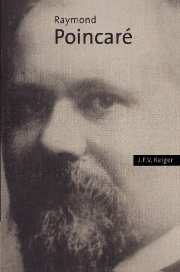Book contents
- Frontmatter
- Contents
- Acknowledgements
- Introduction
- 1 The private man
- 2 Poincaré the politician
- 3 Poincaré the Opportunist
- 4 Poincaré en réserve de la République
- 5 Poincaré the diplomat
- 6 Poincaré President of the Republic
- 7 Poincaré-la-guerre
- 8 Poincaré-la-paix
- 9 Poincaré-la-Ruhr
- 10 Poincaré-le-franc
- Conclusion: Poincaré remembered
- Notes
- Select bibliography
- Index
8 - Poincaré-la-paix
Published online by Cambridge University Press: 06 July 2010
- Frontmatter
- Contents
- Acknowledgements
- Introduction
- 1 The private man
- 2 Poincaré the politician
- 3 Poincaré the Opportunist
- 4 Poincaré en réserve de la République
- 5 Poincaré the diplomat
- 6 Poincaré President of the Republic
- 7 Poincaré-la-guerre
- 8 Poincaré-la-paix
- 9 Poincaré-la-Ruhr
- 10 Poincaré-le-franc
- Conclusion: Poincaré remembered
- Notes
- Select bibliography
- Index
Summary
When the armistice was signed and the cease-fire came into operation on the eleventh hour of the eleventh day of the eleventh month of 1918, Poincaré was fifty-eight years of age. This was young in comparison to many senior French politicians of his day: Clemenceau was seventy-eight, Alexandre Ribot seventy-six, Freycinet ninety. Admittedly a new generation of politicians was about to emerge, but despite his youthful age Poincaré tended to be regarded as belonging to that generation alongside which he had always served, albeit rather precociously. He had been the youngest député in France at 26, the youngest rapporteur of the budget at 30, the youngest education minister ever at 33, had turned down the premiership at 38, and had become the youngest ever president of the Republic at 52. Little surprise, given his comparative youth, that he should think of continuing his political career at the end of his mandate as president, which was to come to a close in a little more than a year on 18 February 1920. Indeed, for a number of years he had even wished that he had not been president of the Republic but président du conseil, so few were the powers, in his view, invested in the presidency. When asked on New Year's Day 1919 by Paul Deschanel, president of the Chamber of Deputies, whether he would be willing to stand for reelection as president of the Republic, Poincaré emphatically replied no.
- Type
- Chapter
- Information
- Raymond Poincaré , pp. 240 - 273Publisher: Cambridge University PressPrint publication year: 1997



